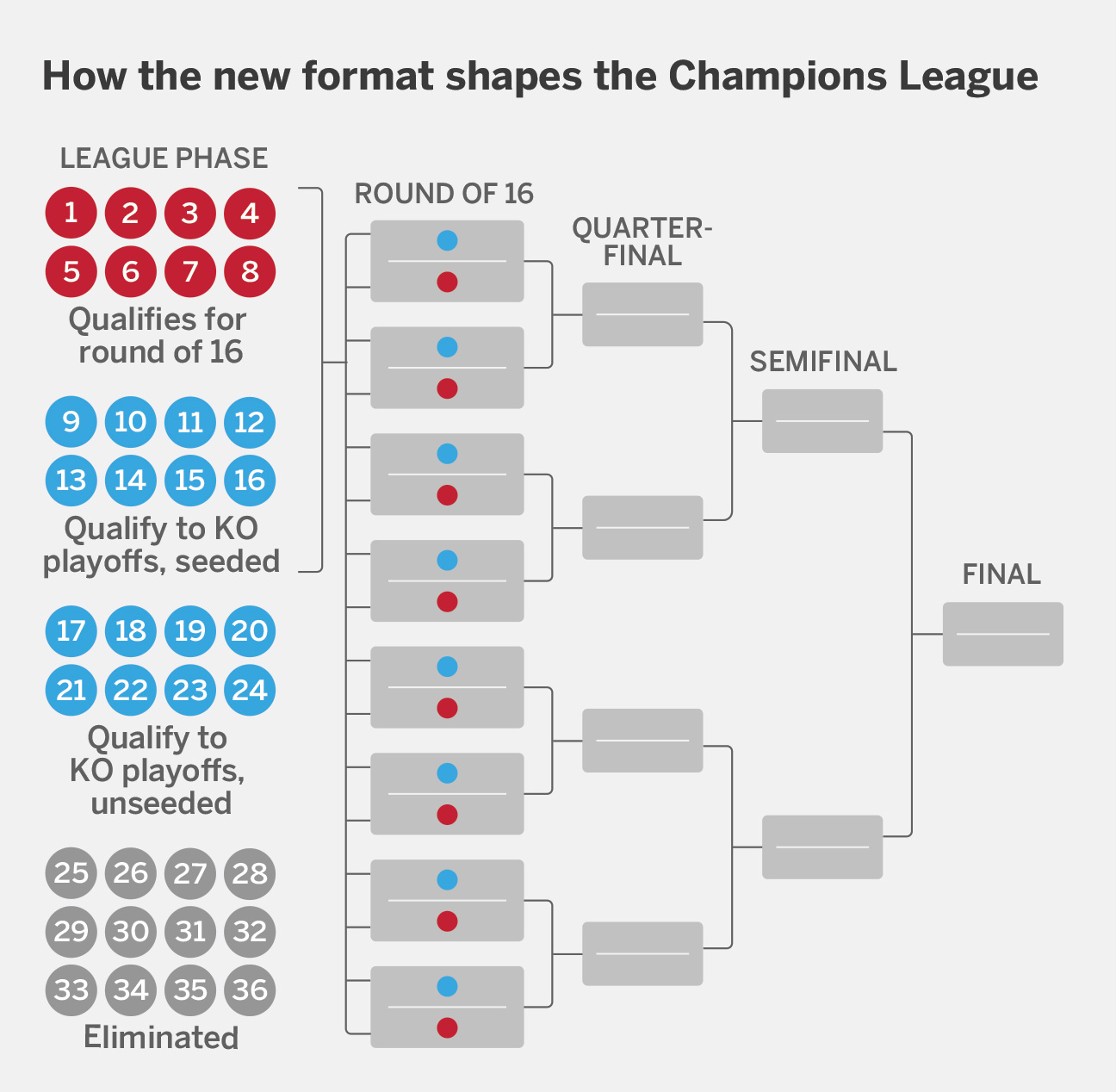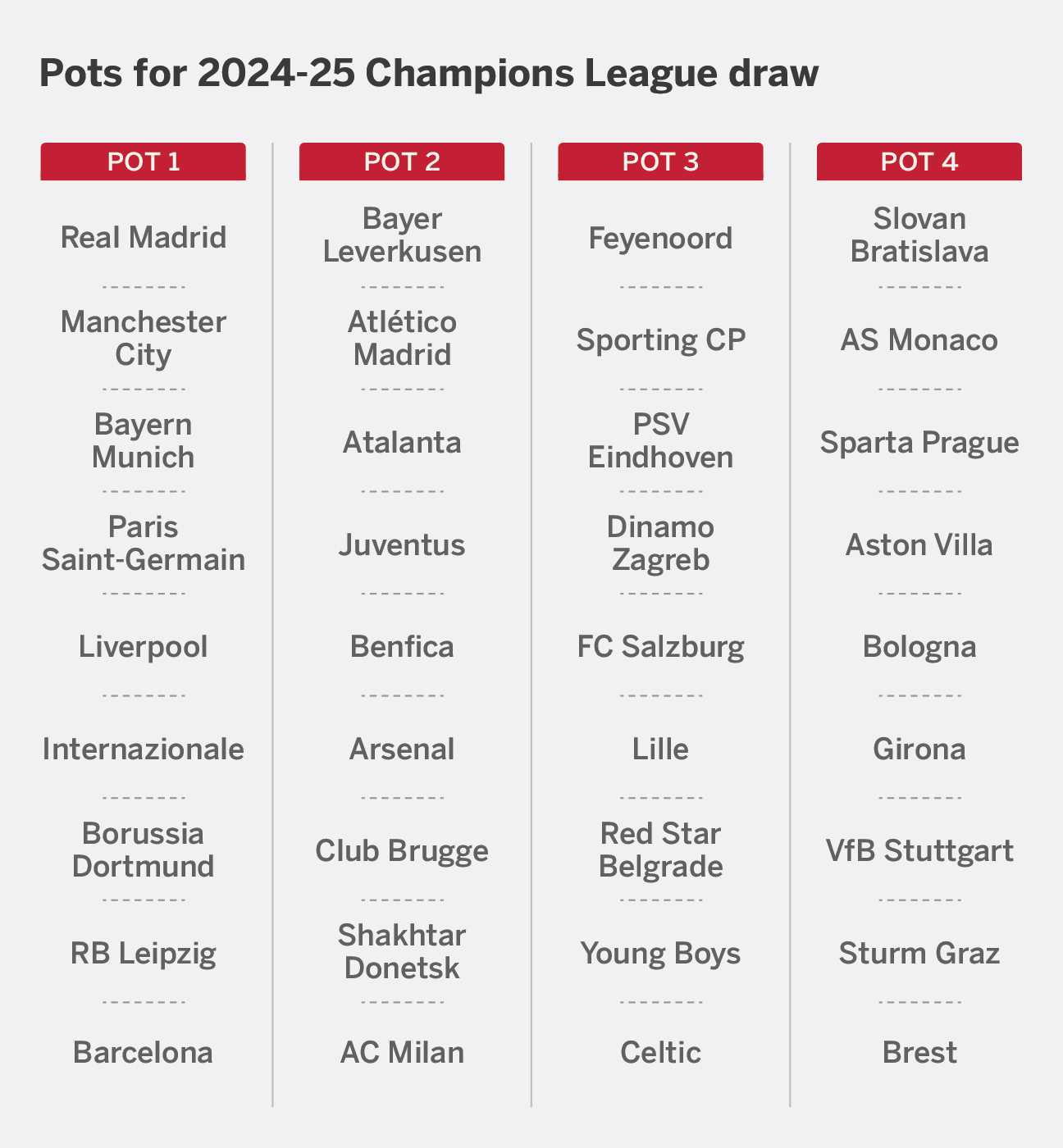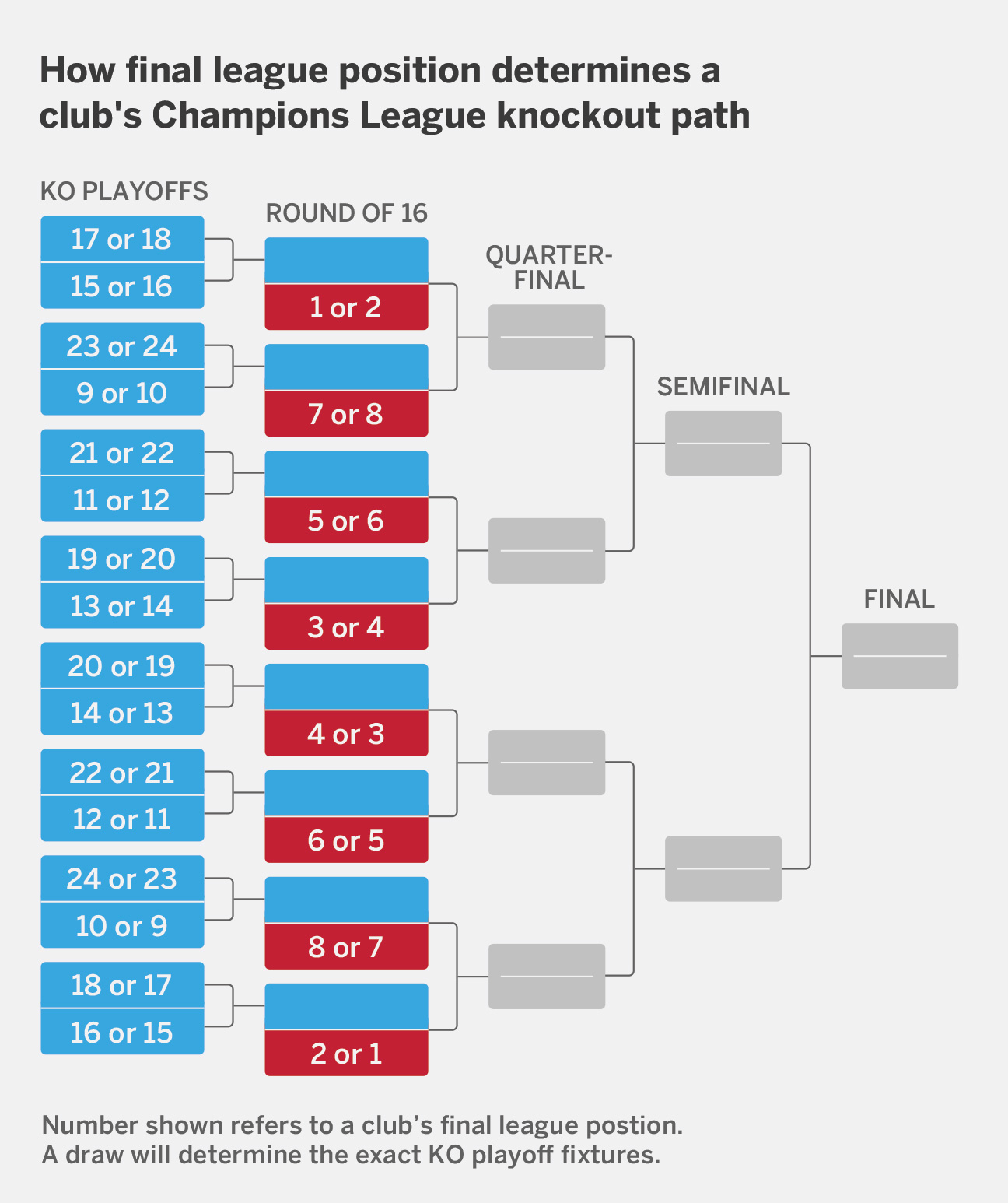The UEFA Champions League is back, but not how we've ever seen it before. Some changes are simple, others are more complicated, and a few might seem a bit of a mystery until we get to the knockout rounds in February.
So, what is the new format? How did the draw work? And what will the league phase look like?
What is the new Champions League format?
Let's start with the basics. This season marks the first time in 21 years that we've had a format change for Europe's top club competition. For the previous 21 seasons, 32 teams qualified and were drawn into eight groups of four. The top two teams went through to the round of 16, with third dropping into the UEFA Cup/Europa League and fourth eliminated from Europe.
We now have 36 teams, but they are no longer drawn into groups. Instead, we have the Champions League "league phase."
So, how does it work?
• Teams were drawn to play eight fixtures, four at home and four away
• Teams in positions 25 to 36 are eliminated in January
• The 16 teams in positions 9 through to 24 play in the knockout phase playoffs, in February, to earn a place in the round of 16
• The top eight go straight through to the round of 16, played in March

Also new for this year: it's no longer possible to drop into the Europa League from the Champions League (or into the Conference League from the Europa League). Once you're out, you're out.
From the knockout phase playoffs onwards, the competition retains its two-legged format through to the semifinals, with a traditional one-legged final, but with limited draws -- more on that later.
Ok, so how were the fixtures created?
Rather than groups, the Champions League draw created individual eight-game fixture lists for each of the 36 participants.
Not much changed in how the draw looked on paper, as there were still four pots of teams that contained nine clubs rather than eight. But there were still some notable adjustments given the expanded field.
How seeding changed
Pot 1 used to house the holders of the Champions League and Europa League, plus the champions of the top six domestic leagues. Pots 2 through 4 would then be ordered by strength based on UEFA's club coefficient, which ranks clubs on performance in Europe over the previous five seasons.
Now only the Champions League titleholders were automatically in Pot 1, all other positions are based upon the UEFA club coefficient. This is intended to give a sliding scale of strength down through the pots, so teams face two opponents from each bracket.
However, the new Champions League format means the pot you are in has less relevance, as teams were drawn to play two clubs from their own pot. Under the old system, being in Pot 1 could give you a more generous draw, as you couldn't play teams from the strongest pot in the group phase.

There were two main principles to the draw this season:
• No club could play another team from their own league (for example, Arsenal couldn't play Aston Villa)
• A club could play no more than two teams from one country (as Arsenal drew Inter and Atalanta, they couldn't then play Bologna)
The draw ceremony was noticeably different, too. In previous seasons, the fates of all 32 teams would be decided by a manual draw, with balls and pots for teams and groups, by a parade of former Champions League players. But the new format is so complicated that it would have taken over three hours and require 1,296 balls to complete in the same way.
Here's how it worked:
• A team was drawn by an ex-player on stage (starting with Pot 1 and ending with Pot 4)
• A computer randomly selected that club's eight opponents (subject to the constraints of the draw) after Cristiano Ronaldo pressed a button on the stage, and that also determined which match is to be played home or away
The pots might not be so crucial, but they still had relevance as each contained a range of quality. The distribution of home and away games was also important given the range of possible opponents for each club.
Each team was given fixtures against two opponents from each pot, and this is how it worked out for Liverpool.

Here's the draw for some selected clubs, and the draw in full is here.
Taking the average UEFA coefficient from the teams each club has drawn, Paris Saint-Germain have the most difficult task of those in Pot 1. The Ligue 1 champions have to face Bayern Munich, Manchester City, Atlético Madrid and Arsenal, with an average coefficient across the eight games of 69.625.
The easiest draw among the Pot 1 clubs was handed to holders Real Madrid, with an average coefficient of 56.000. But they must still host Borussia Dortmund in a repeat of last year's final, and travel to Liverpool.

Despite drawing Real Madrid, Barcelona and Arsenal, it is Atalanta who face teams with the lowest average coefficient (55.375) from Pot 2.
Dortmund (and Brest) must also face both Clasico teams in the league phase -- but the Bundesliga club's task is made easier by getting, on paper, the most favourable draw from Pot 2, Shakhtar and Club Brugge.
Young Boys have the best draw of all (53.125) with games against Inter, Barcelona, Atalanta and Shakhtar from the top two pots.
And the most difficult fixture list belongs to Feyenoord (72.562) as they line up against Man City, Bayern, Bayer Leverkusen and Benfica.
What is the league phase actually going to look like?
The league phase kicks off this week, and you can check out all the fixtures here.
There have been some comments that the league phase could be quite dull, that there'll be little to play for as the top eight clubs will qualify directly to the round of 16, and the next 16 will all go into the knockout phase playoffs. We're only going to lose 12 teams out of 36 at the end of the league phase.
We've put together a league table to show what the new Champions League could look like after seven matches. This should provide a snapshot of how close positions might be, and what's still at stake.
With only 24 points available to each team, the table won't be anywhere near as spread out as a domestic league; indeed, it's possible for a club to move up or down by seven or even eight places on matchday eight.
After seven rounds:
• Two clubs were guaranteed top eight
• 17 clubs were in contention for the six remaining top eight spots
• 17 clubs were guaranteed minimum of a place in the knockout phase playoffs
• No club was completely locked in the knockout phase playoffs
• 14 clubs were vying for the last five spots (20th to 24th) in the knockout phase playoffs
• Only three clubs (34th to 36th) were already eliminated
Taking into account the number of matches and teams involved, 15 points might usually be enough to finish in the top eight, with nine for a place in the top 24. There could be seasons where more points are required, and you would probably be safer on 16 or 17; indeed in our mock some did miss out on 15 points due to inferior goal difference.
To try to make every game important through to the final day, UEFA has linked a club's final league position to the knockout bracket, meaning where a club finishes affects their path. The higher you are placed, the easier the route (based on league ranking) through to the final. For instance, the teams who finish in first and second cannot play each other until the final; those who are third and fourth would avoid first and second until the semifinals, and so on (check out the knockout round chart to see how this falls into place.)
The question is how much those clubs in the middle section will really care about their final placing. Of course, if they outperform their UEFA coefficient ranking they might get a more favourable route to go deeper into the tournament, but even that is reliant on the relative performance of others (e.g. they might play a top team who has had a below-par league phase.)
In our table after seven rounds, only two clubs -- Real Madrid and Manchester City in first and second -- were guaranteed their place in the round of 16, while the bottom three were out.
And that brings us to the mammoth final matchday, when all 18 matches will be played simultaneously -- like the last day of the Premier League season.
Positions could be changing every time a goal goes in, from those key spots near the top of the league to the clubs trying to hang onto, or force their way into the top 24.
Here's what our simulated final round results looked like and how they impacted the table.
NB: This is purely illustrative and not predictive.
Two clubs lost their places in the top eight, with a defeat for Liverpool against PSV Eindhoven seeing them fall six places into 13th. Inter also missed out after drawing at home to AS Monaco, dropping three places to 11th.
The beneficiaries were Borussia Dortmund and Bayern Munich, with wins against Shakhtar Donetsk and Slovan Bratislava taking them both up two places into seventh and eighth respectively. Despite getting 15 points, Paris Saint-Germain, AC Milan, Inter and Aston Villa missed out on the top eight on goal difference.
Positional changes could be more pronounced in the battle to sneak into the top 24 -- as fewer teams are likely be winning matches. Indeed, victories for Lille and PSV saw those clubs move up four and five spots respectively to make the knockout phase playoffs, finishing 23rd and 24th. Brest and Celtic fell out of the top 24 with final-day defeats.
When will the games be played?
Kick-off times will remain the same, with two matches at 5.45 p.m. UK / 12.45 p.m. ET and the rest at 8 p.m. UK / 3 p.m. ET. However, on the final day of the league phase all 18 matches will begin at 8 p.m. UK / 3 p.m. ET.
UEFA has expanded the footprint of the European calendar to cover 10 midweeks, rather than the six it used to. The Champions League will take up eight matchdays, with the spare two used to give the Europa League and Conference League their own standalone weeks. Only the Champions League will play on the week of Sept. 17-19, with the Europa League taking Sept. 25-26 and the Conference League on Dec. 19.
The Champions League league phase will now finish in January, rather than December, with six games played before Christmas and the last two rounds on Jan. 21-22 and Jan. 29.
With the new format producing multiple Pot 1 fixtures, when in previous seasons there wouldn't be any at all, UEFA looks to create a spread of "marquee" matches across the matchdays. Here's how they map out for the 2024-25 season.
How do the knockout rounds and the bracket work?
UEFA used to hold draws throughout the knockout rounds, but the new method of using the league ranking to build the bracket means just two are required: one for the knockout phase playoffs (Jan. 31), and another for the round of 16 (Feb. 21) to complete the bracket.
There is no country protection, so for instance, Liverpool could play Aston Villa in the round of 16. In past seasons, country protection remained in place until the quarterfinals.
The strength of teams in the expanded tournament means some heavyweight teams are likely to miss out on the top eight, and that could create some blockbuster ties early in the knockout stage.

The first draw on Jan. 31 creates the knockout phase playoff fixtures, with each team having two possible opponents, and places the game into the bracket.
Clubs ranked 9-16 play the second leg at home. From this point, the position in the bracket is set for these teams.
From the final positions in our sample league table, the following knockout phase playoff ties are possible.
At the end of the league phase the top eight clubs will each have four possible round-of-16 opponents, based upon the build of the knockout bracket. They will play the second leg at home in the round of 16.
Taking our league table, it would fit together like this:
Real Madrid (1) or Manchester City (2) would play:
Winners of one of the ties involving Bologna (17), AS Monaco (18), Atlético Madrid (15) and Sporting CP (16)
Barcelona (3) or Arsenal (4) would play:
Winners of one of the ties involving Stuttgart (19), Benfica (20), Liverpool (13) and Juventus (14)
Bayer Leverkusen (5) or RB Leipzig (6) would play:
Winners of one of the ties involving Young Boys (21), FC Salzburg (22), Internazionale (11) and Aston Villa (12)
Borussia Dortmund (7) or Bayern Munich (8) would play:
Winners of one of the ties involving Lille (23), PSV Eindhoven (24), Paris Saint-Germain (9) and AC Milan (10)
The round of 16 draw on Feb. 21 will see the teams ranked 1-8 drawn into one of their two possible positions, which will automatically create a fixture against the relevant winners of the knockout phase playoffs, which will already have been completed. Clubs ranked 1-8 play the second leg at home.
And that's that, the Champions League knockout bracket is complete and on Feb. 21 all clubs will know who is in their half of the draw, and who they won't have to get past. A draw is conducted to determine which team plays the first leg match at home for the quarterfinals and semifinals.
